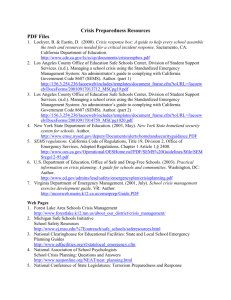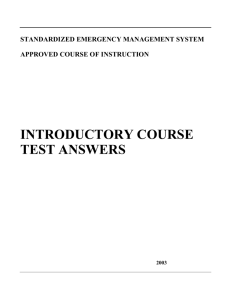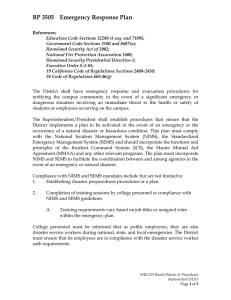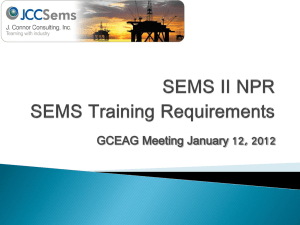GEOINFORMATION AND STANDARD FOR SYNTHETICAL EMERGERNCY MANAGEMENT SYSTEM
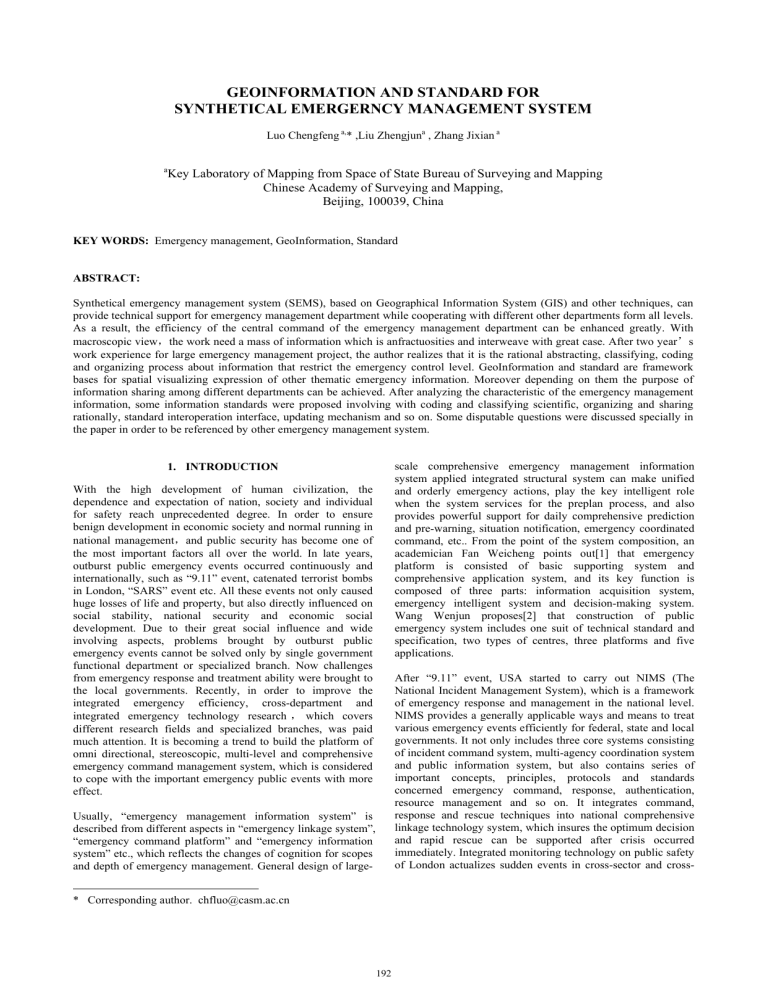
GEOINFORMATION AND STANDARD FOR
SYNTHETICAL EMERGERNCY MANAGEMENT SYSTEM
Luo Chengfeng
a,
* ,Liu Zhengjun a
, Zhang Jixian
a a
Key Laboratory of Mapping from Space of State Bureau of Surveying and Mapping
Chinese Academy of Surveying and Mapping,
Beijing, 100039, China
KEY WORDS:
Emergency management, GeoInformation, Standard
ABSTRACT:
Synthetical emergency management system (SEMS), based on Geographical Information System (GIS) and other techniques, can provide technical support for emergency management department while cooperating with different other departments form all levels.
As a result, the efficiency of the central command of the emergency management department can be enhanced greatly. With macroscopic view , the work need a mass of information which is anfractuosities and interweave with great case. After two year ’ s work experience for large emergency management project, the author realizes that it is the rational abstracting, classifying, coding and organizing process about information that restrict the emergency control level. GeoInformation and standard are framework bases for spatial visualizing expression of other thematic emergency information. Moreover depending on them the purpose of information sharing among different departments can be achieved. After analyzing the characteristic of the emergency management information, some information standards were proposed involving with coding and classifying scientific, organizing and sharing rationally, standard interoperation interface, updating mechanism and so on. Some disputable questions were discussed specially in the paper in order to be referenced by other emergency management system.
1.
INTRODUCTION scale comprehensive emergency management information system applied integrated structural system can make unified
With the high development of human civilization, the dependence and expectation of nation, society and individual for safety reach unprecedented degree. In order to ensure and orderly emergency actions, play the key intelligent role when the system services for the preplan process, and also benign development in economic society and normal running in national management , and public security has become one of provides powerful support for daily comprehensive prediction and pre-warning, situation notification, emergency coordinated command, etc.. From the point of the system composition, an the most important factors all over the world. In late years, outburst public emergency events occurred continuously and internationally, such as “9.11” event, catenated terrorist bombs in London, “SARS” event etc. All these events not only caused huge losses of life and property, but also directly influenced on social stability, national security and economic social development. Due to their great social influence and wide involving aspects, problems brought by outburst public emergency events cannot be solved only by single government functional department or specialized branch. Now challenges from emergency response and treatment ability were brought to the local governments. Recently, in order to improve the integrated emergency efficiency, cross-department and integrated emergency technology research
, which covers different research fields and specialized branches, was paid much attention. It is becoming a trend to build the platform of omni directional, stereoscopic, multi-level and comprehensive emergency command management system, which is considered to cope with the important emergency public events with more effect.
Usually, “emergency management information system” is described from different aspects in “emergency linkage system”,
“emergency command platform” and “emergency information system” etc., which reflects the changes of cognition for scopes and depth of emergency management. General design of largeacademician Fan Weicheng points out[1] that emergency platform is consisted of basic supporting system and comprehensive application system, and its key function is composed of three parts: information acquisition system, emergency intelligent system and decision-making system.
Wang Wenjun proposes[2] that construction of public emergency system includes one suit of technical standard and specification, two types of centres, three platforms and five applications.
After “9.11” event, USA started to carry out NIMS (The
National Incident Management System), which is a framework of emergency response and management in the national level.
NIMS provides a generally applicable ways and means to treat various emergency events efficiently for federal, state and local governments. It not only includes three core systems consisting of incident command system, multi-agency coordination system and public information system, but also contains series of important concepts, principles, protocols and standards concerned emergency command, response, authentication, resource management and so on. It integrates command, response and rescue techniques into national comprehensive linkage technology system, which insures the optimum decision and rapid rescue can be supported after crisis occurred immediately. Integrated monitoring technology on public safety of London actualizes sudden events in cross-sector and cross-
* Corresponding author. chfluo@casm.ac.cn
192
domain can acquire accurate positioning and be supported optimum decision and emergency treatment within 5-10 minutes.
Pine, John C. pointed out[3] it is an important trend of emergency work to eliminate the inharmonious factors among government sector, business department and social forces throughout the emergency response procedure. This paper regards spatial data and standards as cutting points, studies on scientific classification and coding, reasonable organization and sharing, interface standards among departments, information updating mechanism, etc. According to the characteristics of
SEMS, the work tries to integrate all information related to emergencies, uses technical and information standard to guarantee the cooperative work among government sector, business department and social forces through the emergency response procedure, reduces the adverse effect of emergency events to minimum extend.
2.
INFORMATION CHARACTERISTICS FOR SEMS
SEMS is an open system, which is consistent to unified command, cross-sector and cross-domain response, apanage as center. SEMS takes different administrative rank and emergency management information system of specialized department as nodes, which leads to up and down transfixion, left and right cohesion, interconnection, information sharing, mutual relies, mutual support, and safe smooth. As a “unified, sensitive, efficient, reliable” technology support platform,
SEMS must meet the demand for timeliness, coordination, specialization and socialization requirements, etc. The following characteristics are obvious for the information using by SEMS.
Complexity The characteristic is determined by diversity and uncertainty of emergency events which are embodied by events types, destroyed extent, pre-protected methods. As the information reserve for emergency response, it makes a precaution measures. It involves not only certain kinds of complex nature and humanistic information related to emergency, but also contains both objective information reflecting event spots and subjective information like general knowledge, rules of law, correlative policy and so on. Like other information, it also has hierarchy or grade which can be divided to strategy, tactics and operation levels. Only if the complex information is carded reasonably and clearly, the
SEMS could have solid foundation.
Openness With multitudinous structural hierarchies and various subsystem types, SEMS mainly implements the horizontalvertical cooperative work among multi-departments and multigovernments to magnitude outburst public events. In order to integrate numerous sources, emergency management information should be organized by multi-network, and the node in the network represents a special department or sector.
Based on such mechanism, the interconnection and intercommunion of subsystem nodes in SEMS can be reached.
Some rules are forming gradually, including taking SEMS as centers, vertical function system of multi-level responses, apanage management, transverse function systems of information sharing and division-cooperation. It is impractical for one single department to product and to reserve so many data. Emergency management information must be open, which integrates specialization of different departments and benefit coordination of different management levels. After known the characteristic, there are several problems should be considered carefully, such as in which precondition and level the information can be provided, what contents and how details should be shared.
Timelines s
Emergency command process is actually an integration of decision and implementation process under a series of constraint condition and finite-time. As paramilitary action, the outstanding characteristics of the action include critical time and momentous influence. Scientific and rationality of decision, together with timeliness and actual utility of implementation process, fundamentally depend on whether decision and implementation process are based on comprehensive, accurate and timely information. If information is outdated, the biased or false results may be concluded in the decision process, which make the SEMS lose its due function.
With the complex emergency information, there are some important questions worthy of analyzing seriously and qualifying concretely, like using which standard to determine time sensitivity of different kinds of information and make the reasonable update cycle.
Spatialit y
Geoinformation and GIS technology are important support for the SEMS. It is estimated that more than 70% information in actual world is relevant with spatial position.
People’s first response to sudden events is where they happen and what influence to the surroundings. Spatial position information is very important to deal with outburst events. The development of GIS technology can help people understand visually the event spot information in first time. Systematic reserve and standardized, systematic management of emergency management information are important basis SEMS. In order to be a successful integrated emergency management information system, The scale and precision of spatial data, the ways coupling with other information, the scale and precision of spatial data for reference, and coupling mode between spatial data and other information, need cautiously dealing with..
3.
SEMS ’ S INFORMATION CONTENTS
Chinese academician Wang [2] figures out than emergency management system is a systems engineering, which takes the whole response process for outburst accident as masterstroke, covers following courses: watching and supervising, forecasting and pre-warning, alarming, commanding, concluding, dealing with problems after the event, resuming and rebuilding. SEMS adopts incorporate structure to make the general design of the platform, which ensure the whole response action harmoniously and orderly, exert the key intelligent role serving for emergency management pre-process case flow, and provide powerful support for daily synthetical prediction and pre-warning. The following figure shows the incorporate emergency management mechanism, which embodies the whole process of the incorporate management.
Emergency management information of SEMS is ligament which links multifarious activities during the whole process.
And SEMS can provide speedy, effective and safe guarantee for emergency management functions suited different phases.
According with incorporate emergency management mechanism, the information within SEMS can be divided five parts. (1) Basic knowledge and pre-process cases, which include not only the types of emergency events, for example there are four main classes in china: nature disaster, accident tragedy, public sanitation event and welfare event, but also preprocess cases corresponding with different event type,
193
emergency management and old case, regulations for security guarantee. The information is static and can be enriched by collecting data. (2) Geoinformation, which covers all spacial data correlated with emergency management, such as nature environment, social economics, etc. Geoinformation almost includes all emergency thematic information, and the part is the foundation to make the scientific decision-making combing around the site. Including multi-resolution image data, DEM data, geographical names data, geological data, topographic data, forest cover data, climate/ meteorological data and other reflecting the status of the natural environment data; population distribution, a handful of family, nature reserves, socioeconomic statistical data, and other reflecting the human environment and socio-economic situation data.(3) The risk
Event scene information Specialty team Emergency management
Prediction and prewarning
Information
release
Surveillance and management
Security safeguard
Pre-alarming and preventing
Correlated specialty information
Natural environment information
Key protected objects
Key infrastructure
Deciding with synthetical information
Prediction and analysis
Decision-making with assistance
Pre-process case and leading case
Expert system long-distance negotiate …
…
Making scheme
Repertory material
Succor equipment
Traffic and conveyance guarantee
Rescuing with medical treatment
…
Succor commanding
Deal with problems arising from an event
Investigate and evaluate
Resume and rebuild
Resuming and rebuilding after the event
Figure.1 SEMS incorporate emergency management mechanism with GIS technique. It is necessary for deciding with synthetical information, making scheme and succor commanding process.
(3) Daily operation information, which includes daily management information, alarming records, prediction and prewarning information, supervise management information, release information. All these information can provide unanimous information for succores and original information for investigating and analyzing. (4) Succor commanding information, mainly includes the results of prediction and prewarming submitted by specialty department, decision-making, long-distance negotiate, ect. Various interim information correlating with commanding process also attach to this part. (5)
Information about resuming and rebuilding after the event, which include various information about event investigating and evaluating, dealing with problems arising from the event, resuming and rebuilding.
4.
SEMS ’ S GEOINFORMATION CONTENTS AND
ORGANIZATION
Associated with Emergency thematic information, SEMS’s geoinformatin covers emergency response process in all aspects of outburst events, and can be divided into five main categories:
(1)The framework information: the basis of geospatial data is basis for the framework of emergency thematic information which is accurate registration and integration of a variety of contingency. Small-scale basic geospatial data changes infrequently, and use with high frequency; but cities and towns’ large-scale geo-spatial basic data changes faster and update cycle should be relatively shorter. Those relatively high-level strategic information in SEMS is often based on small-scale framework information, on the contrary, those information used in the operating level is more large-scale data.(2) Emergency background information: used to reflect natural and human environment, socio-economic situation that surrounded the outburst events spot, through the two-dimensional / threedimensional and statistic charts based on these information , the system intuitive reproduce the real situation from various angles sources and potential risk District: During the response to natural disaster emergencies, it’s need to be clear the potential risk District that may be affected around the emergencies , they may be the source of secondary disasters, and should be precautionary. In responding to disasters in accidents, public health and social security during the incident, to determine the source of potentially dangerous is a prerequisite to avoid the occurrence of secondary disasters and make a correct choice of the necessary conditions. (4) Protection objectives: during the disposal of unexpected events, some important features in need of special attention, and it is necessary to try to ensure that it does not suffer. For example, the Government resident, Key cultural relics conservation, the key infrastructure etc. (5)
Support resources: support resources include human resources and material resources, human resources including: all kinds of experts, professional rescue teams, medical personnel, etc.; the latter including rescue equipment, material reserves, transport, security, medical care, etc.
Each category of the emergency thematic information in the top-five contains more detailed information with sub-categories.
These sub-categories of information performed in the form of spatial data layer, more detailed information to be reflected in the layer properties. Emergency thematic information is very comprehensive; only one part of information content is being used in the disposal of a certain category of unexpected events. in order to enhance large-scale integrated emergency management information system effectiveness, we should to organize the data content based on the types of emergencies, for example, in those accident disaster disposal, the information mainly include: the basis of geospatial data, high-resolution images, population distribution, nature reserves, socioeconomic statistical data, the risk of a major source of secondary disasters, pipeline facilities, professional rescue, traffic and transportation security, medical care and so on..
194
5.
EMERGENCY THEMATIC INFORMATION
STANDARD
6.
CONCLUSION
The content of information and the organization is based on the integration of emergency management mechanism, it is just a framework, in order to put them into practice, the details of which for further standardization is necessary . First of all standards is to determine the classification and coding rules of the emergency information contents, in accordance with section
II, the content can be divided into five categories, each category was divided into a number of the following sub-categories. For example, the topic of Geoinformation also can be divided into five categories. Category-level should not be too much, and three categories can express the basic emergency information clearly. According to the needs, category and its sub-class can be expanded. In order to facilitate information sharing and visual expression a unified icon is needed, at the same time you must pay more attention to the combination of simple and practical need when coding. Unified information classification and coding as well as the icon of expression, guaranteed emergency information between different systems can interoperate.
Geoinformation storage and expression followed the expression rules of spatial data, the same information need to be described with the point, line and surface according to specific characteristics of the expression object, and other more detailed information can expressed through its attribute. It requires information content, presentation (point, line and surface) and attributes should have a clear and detailed definition and regulation in standards, and further, the content of the options of some attributes should also be given specific items. In the definition of specific attributes, we must pay attention to consider the professional needs of the relevant professional departments and emergency needs as well, where the information is aimed to give service to the emergency decisionmaking, should not be too professional.
The emergency information in the SEMS was network distribution; different levels of emergency management departments and the professional sector are nodes of the network. Data on the different nodes shares a same basic geospatial information framework. The information difference is mainly reflected by the data accuracy of different levels node.
The difference of same level is mainly reflected in the regional scope. Different professional sectors node information is mainly reflected in data content. Data of each node followed the overall framework of emergency information and information classification and coding rules. In principle, higher-level emergency management departments can share all node information of lower levels, the higher professional departments can share all professional nodes information of subordinate departments; emergency management departments can share information on all nodes at the same level, but not the professional sector.
Each node should provide the meta-data information of its own share information, and responsible for regularly updated data.
Professional department’s data should be updated by professional departments, and emergency management department’s node information related to the professional departments. It is recommended to provide a standard data interface by the emergency management department which can benefit the professional sector to update data regularly.
SEMS embodies the Omni-directional, three-dimensional, multi-level and integrated emergency command and management mechanism of thinking. Information management system can not be separated from the data support, geoinformation content and standards are basis for SEMS. In this paper, the geoinformation content and standards of the framework to put forward combined with an integrated emergency management mechanism, in the formulation of specific standards for the course, there are many complicated details need to be carefully considered, for example, how to combine factors interrelated data accuracy, such as spacial data scale, remote sensing image resolution, data level hierarchy and so on, with event type and the damage scale. Another example, how to define the conditions and constraints when expand the new type and code in order to facilitate the sharing between different levels. It’s only the first step for the system to achieve the functions and expected Target when we classification, organization these data and organic integration these data with systems. Both vertically and horizontally, to combined more departments and the level of the platform into a network platform and made it to play a greater role, to guarantee the update of information will be the deeper protection for the system data content and standards need to be amended during applications in order to enable the system to play a greater role..
R
EFERENCES
Fan Weicheng, Yuan hongyong. Analyses and countermeasure for current situation of building Chinese emergency management platforms. Informatization construction, 2006,
(9):14-17.
Wang Wenjun. Outburst public event emergency management information system and technology system. 2005, (9):18-20.
Pine, John C. Research needs to support the emergency manager of the future. Journal of Homeland Security and
Emergency Management, 2004, 1(1):1-9.
A
CKNOWLEDGEMENTS
The author would like to acknowledge the Chinese Academy of
Surveying and Mapping and Xinjiang Geomatics Center for providing an emergency management project that enabled us to undertake this study.
195
